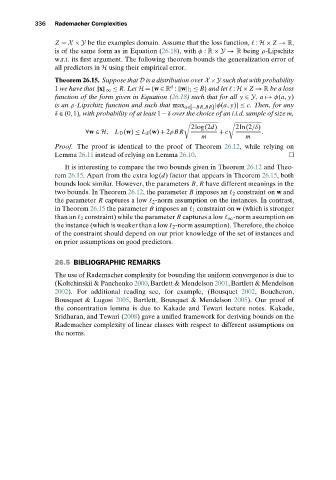Page 354 - Understanding Machine Learning
P. 354
Rademacher Complexities
336
Z = X × Y be the examples domain. Assume that the loss function, : H × Z → R,
is of the same form as in Equation (26.18), with φ : R × Y → R being ρ-Lipschitz
w.r.t. its first argument. The following theorem bounds the generalization error of
all predictors in H using their empirical error.
Theorem 26.15. Suppose that D is a distribution over X ×Y such that with probability
d
1 we have that x ∞ ≤ R.Let H ={w ∈ R : w 1 ≤ B} and let : H× Z → R be a loss
function of the form given in Equation (26.18) such that for all y ∈ Y, a è φ(a, y)
is an ρ-Lipschitz function and such that max a∈[−BR,BR] |φ(a, y)|≤ c. Then, for any
δ ∈ (0,1), with probability of at least 1−δ over the choice of an i.i.d. sample of size m,
2log(2d) 2ln(2/δ)
∀w ∈ H, L D (w) ≤ L S (w) + 2ρBR + c .
m m
Proof. The proof is identical to the proof of Theorem 26.12, while relying on
Lemma 26.11 instead of relying on Lemma 26.10.
It is interesting to compare the two bounds given in Theorem 26.12 and Theo-
rem 26.15. Apart from the extra log(d) factor that appears in Theorem 26.15, both
bounds look similar. However, the parameters B, R have different meanings in the
two bounds. In Theorem 26.12, the parameter B imposes an 2 constraint on w and
the parameter R captures a low 2 -norm assumption on the instances. In contrast,
in Theorem 26.15 the parameter B imposes an 1 constraint on w (which is stronger
than an 2 constraint) while the parameter R captures a low ∞ -norm assumption on
the instance (which is weaker than a low 2 -norm assumption). Therefore, the choice
of the constraint should depend on our prior knowledge of the set of instances and
on prior assumptions on good predictors.
26.5 BIBLIOGRAPHIC REMARKS
The use of Rademacher complexity for bounding the uniform convergence is due to
(Koltchinskii & Panchenko 2000, Bartlett & Mendelson 2001, Bartlett & Mendelson
2002). For additional reading see, for example, (Bousquet 2002, Boucheron,
Bousquet & Lugosi 2005, Bartlett, Bousquet & Mendelson 2005). Our proof of
the concentration lemma is due to Kakade and Tewari lecture notes. Kakade,
Sridharan, and Tewari (2008) gave a unified framework for deriving bounds on the
Rademacher complexity of linear classes with respect to different assumptions on
the norms.

